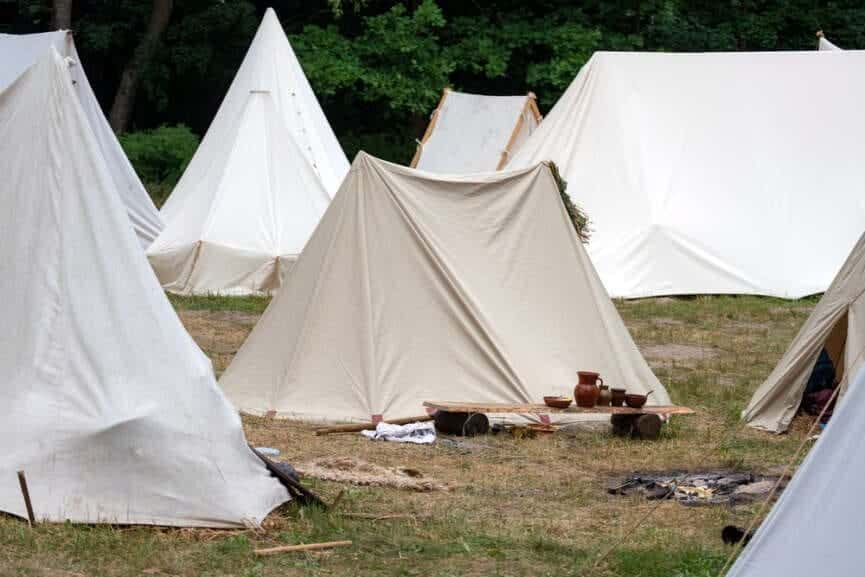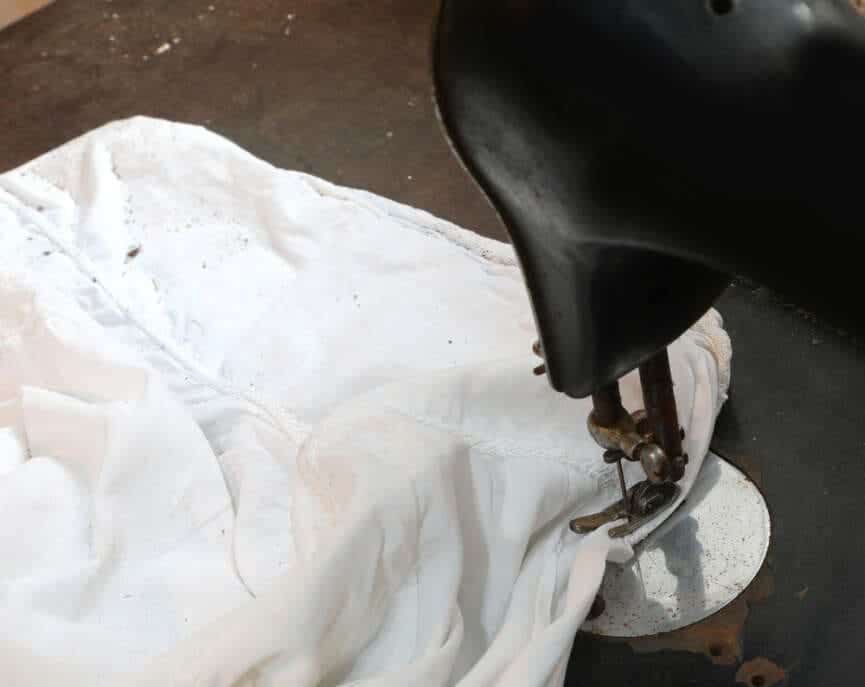Ask any outdoor enthusiast and tell you how tents are the most essential outdoor equipment for camping, hiking, and exploring. In fact, you can argue it is also pretty useful for other recreational activities too.
But there is one problem: not only tents are some of the biggest expenses when it comes for preparation while having no personally at all.
While many tents are readily available for purchase at any specialty store. There’s just something special about crafting your own tent. Not only sewing your tent allows you to tailor it to your basic needs. You can also be suited to your specific preferences so that it ensures it meets your camping requirements.
So, In this piece, we will provide an easy guide on how to sew a tent.
We’ll discuss the materials you’re gonna need, the actual step-by-step process, and of course offer tips to help you create a functional tent while giving it a little bit of personality.
1. Materials Required
First of all, Before we even dive into the sewing process. As it’s crucial to gather all the necessary materials and tools.

Here’s a list of the most vital materials you’ll need to sew a tent.
1.1 Fabric
First is of course the fabric. The particular type of fabric you should use depends on the intended use of your tent.
If you are going for a simple lightweight backpacking tent, the material you should consider is ripstop nylon or polyester. Otherwise heavy-duty polyester is suitable for family camping tents. Just ensure the fabric is waterproof or can be treated to make it waterproof.
1.2 Thread
Second, high-quality polyester or nylon that matches the color of your fabric is what you should choose when considering threads.
This thread should be strong and durable to withstand outdoor conditions.
1.3 Zippers
Third is a quality zipper. It all depends on your tent design.
For example you may need zippers for doors, windows, or ventilation. You just wanna make sure these zippers are durable and waterproof.
1.4 Poles
Fourth, the tent poles provide structure and stability to your tent.
And it’s something you can also get online. You can purchase pre-made tent poles. Otherwise you can use materials like aluminum, fiberglass, or carbon fiber to make your own.
1.5 Guy Lines and Stakes
Fifth is the guy lines and stakes. These are essential for securing your tent. Particularly it will help out in windy conditions.
Also, Nylon cordage and lightweight aluminum stakes are commonly used.
1.6 Sewing Machine
Sixth is of course the quality sewing machine.
Remember you wanna only go with a heavy-duty sewing machine with a walking foot or industrial sewing machine.
Both help you make sewing a tent much easier as it ensures you can handle multiple layers of fabric.

2. Tools and additional items
1, Scissors or Rotary Cutter – quality scissors or rotary cutter are essential for precise fabric cutting.
2, Pins and Clips – These will help hold fabric layers together during sewing.
3, Seam Sealer – It is necessary to make your tent seams waterproof. It’s typically applied after sewing.
4, Templates and Patterns – This one Depends on your tent design. It’s where you add templates or patterns to add a bit of personality. Also it will help you cut fabric pieces accurately.
3. Step-by-Step Guide on Sewing a Tent
Now that you’ve gathered all the necessary materials, let’s delve into the step-by-step process that you need to follow for properly a sewing a tent:
3.1 Design Your Tent
First of all, Determine the size and style of your tent. The main factor here is considering the number of occupants and intended use. Start with a detailed sketch or plan that includes dimensions and features. For example doors, windows, zippers and vents.
Remember whether it’s a simple A-frame, dome, tunnel, or geodesic shape or whatever depending on the people it will hold, the space needed to secure it will increase too.
3.2 Prepare the Fabric:
Second, to prepare the fabric, lay out your fabric on a clean, flat surface. Now use your templates or patterns to cut out the necessary fabric pieces. Also for rainfly, floor, and other components.
Here pay attention to grainlines, ensuring the fabric pieces align correctly.
3.3 Reinforce Seams
Third step is to prevent fraying and strengthen seams. First apply a line of seam sealant along the edges of all fabric pieces.
The seam sealer to dry thoroughly before proceeding.
3.4 Start Sewing the Tent Body
Fourth, begin by sewing the main tent body panels together, following your design plan. Here depending on your fabric type, you may have to use a straight stitch or zigzag stitch for added durability.
Now, reinforce high-stress areas such as corners and attachment points. Also reinforce with extra stitches or reinforcing patches.

3.5 Add Zippers and Windows
Fifth step is to Install zippers for doors and windows according to your design.
Make sure your zippers are securely sewn and function smoothly.
3.6 Create the Rainfly
Alright, no to the step sixth, which is to creating a rainfly. Begin by sewing the rainfly separately, ensuring it matches the size and shape of the tent body.
Now attach hooks, snaps, or your other chosen fasteners to secure the rain fly over the tent properly.
3.7 Construct the Floor
Next, it is time to sew the tent floor using waterproof fabric. First ensure the floor is slightly smaller than the tent body to prevent water from pooling inside.
Then begin by making sure of its proper placement now, all you have to do is sew the base side with a strong thread.
3.8 Assemble the Poles and Frame
The eighth step is finally assembling the poles. If you’re using pre-made tent poles all you have to do is assemble them according to the manufacturer’s instructions.
And If making your own poles, begin by cutting and shape them to match your tent’s design.

3.9 Attach Poles to the Tent
On to the ninth step. It is finally time to attach the pole.
Begin by threading the tent poles through the designated sleeves or clips on the tent body. Once done properly erect the tent to check that it stands correctly. And if needed add adequate support.
3.10 Apply Guy Lines and Stakes:Alright, the tenth step in adding the guy lines and stakes. Now, Attach guy lines to the tent’s rainfly or body for added stability.
Stake down the tent to secure it to the ground.
3.11 Test Your Tent:
And last but not the least is to test your tent. Now, all you have to do is take your tent on an outdoor adventure, set it up in your backyard or a controlled environment to ensure it functions correctly.
Also, check for any leaks or issues with zippers, seams, or poles. To finish it just test the waterproofing of your tent. Allow it to dry completely before using the tent in wet conditions.

Closing Thoughts
Hopefully, you are now rocking your new self-made vest with confidence.
With each sewing project, you’ll progress to the next stage. So, whether it’s mastering flat-felled seam or adding door zippers just keep honing your skills on your sewing machines.
What so witing for? creating your very own tent today! If you get into trouble just always use iOS devices or android for tutorials, or even, even better, draft your ideas on graph paper beforehand, ensuring every detail is just right with precision and two lines of dedication.








18 Comments
The information on tent sewing machines was exactly what I needed. Your recommendations were spot-on and made my decision-making process much easier. Thanks!
I’ve always had issues when adding the zippers and windows when making my tent. This article was just all I needed. Now I can fix my zippers and windows without having any issues. Thanks for sharing this, it was really helpful.
Practical and hands-on advice! This article provides clear guidance on tent-sewing techniques.
I found this article on crafting your own tent quite fascinating. As an outdoor enthusiast, the idea of tailoring a tent to my specific needs and preferences sounds appealing. The step-by-step guide, along with insights into required materials and tools, makes the prospect of sewing a tent seem not only doable but also a rewarding endeavor for camping and exploring. It’s refreshing to consider a hands-on approach to such an essential outdoor equipment.
Always there’s a special pleasure in doing the things by our own like the same in tearing a tent according to our preferences give a different kind of pleasure and it also makes us proficient in the tailoring skill it is not difficult but it creates some hurdles while learning.
Crafting adventure gear. ‘Tent sewing insights – your go-to guide for outdoor enthusiasts and DIYers alike.
It is worth going through it and learning how to sew a tent, as it can be of great help in the future. Definitely, I, too desire to make adventure trips in future, so it will be good to learn from here.
I’ve never tried my hand at sewing a tent. However, after seeing those cute babies and the tiny tents in your article, I had some brilliant ideas for creating baby tents to keep my siblings happy and satisfied with another enjoyable small house. Thank you for your efforts in providing fresh ideas for making tents.
This comprehensive guide provides a detailed overview of the materials and steps needed to sew a tent, offering valuable insights for DIY enthusiasts. The comment appreciates the thorough breakdown of essential materials, tools, and a step-by-step process. It acknowledges the benefits of the guide, including practical tips on fabric selection, reinforcing seams, and assembling tent components. The comment highlights the importance of testing the tent for functionality and waterproofing.
Trekking and adventurous trips have become a trend among youth nowadays. This step-by-step guide to making a tent is really helpful for those who plan such trips. It gives us a detailed overview of which material to be used and how to check pitfalls.
This guide provides a comprehensive overview of how to sew a tent, catering specifically to newbies. The step-by-step instructions cover everything from gathering materials to testing the final product. The inclusion of detailed information on essential materials, tools, and additional items ensures that readers are well-prepared for the project. The guide also emphasizes the importance of selecting the right fabric, thread, zippers, poles, and other components based on the intended use of the tent. The clear and organized structure of the guide makes it easy for beginners to follow along, and the accompanying images enhance understanding. Overall, it serves as a valuable resource for individuals looking to embark on the journey of sewing their own tents.
This was quite elaborative and helpful. But I am confused how much cloth piece to buy. I want to sew a tent for 2 people for local camping. Can you suggest?
This article about making your own tent was really interesting to me. Being an outdoor enthusiast, I find it appealing to customize a tent to meet my unique requirements and tastes.
Being a camp lover, tent is the most useful thing. In the progress of making my passion all better sewing tent would be another step. The process and the materials were described so briefly and thank you for the information.
This guide on sewing tents for outdoor enthusiasts is a must-read! It provides a step-by-step process, highlighting essential materials like fabric, thread, zippers, poles, guy lines, and stakes. The guide covers tools such as scissors, pins, seam sealer, and templates. The step-by-step instructions, from designing the tent to testing its functionality, offer valuable insights. Whether you’re a newbie or seasoned sewer, this guide empowers you to create a customized tent tailored to your camping needs.
I didn’t know that I could sew a tent until I read this post. The necessary steps are simple and your post has made them easy to understand. My outdoor experience will change which is something I highly appreciate. Thanks
This guide turned my DIY dreams into reality! Who knew sewing a tent could be this fun and rewarding? Now I’ve got my personalized shelter ready for outdoor adventures. Thanks for making it so easy to follow.
Sewing a tent looks like a difficult task but the way you have written all the steps made it so easy, I can say the author of this post has a good sense of content quality that is to be delivered to audience. This is exactly what I was looking for.